
We speak with Colorado University Environmental Studies professor Adrienne Anderson about the Lowry Landfill. Citizen groups claim the landfill is widely contaminated with highly radioactive plutonium and other deadly wastes. The EPA is allowing the contaminated groundwater at the landfill to be discharged into the Denver metro sewage system, after only partial treatment. [includes rush transcript]
- Adrienne Anderson, professor of Environmental & Ethnic Studies at the University of Colorado at Boulder. In 1997 Anderson filed a federal whistleblower case on a plan to mix plutonium waste with sewer sludge, process it into fertilizer and then use on American farms. She currently works with farmers and unions to stop practices like this taking place around the country today.
Transcript
AMY GOODMAN: Adrienne Anderson, also joining us, Professor of Environmental and Ethnic Studies at the University of Colorado, Boulder.
ADRIENNE ANDERSON: Yes. Mr. McKinley and his other cohorts on the grand jury were convened from 1989 to 92 to look at purported criminal activity at the Rocky Flats nuclear weapons plant. And as their book chronicles, the U.S. Justice Department actually sold them down the river. At the end of their term of service, Mike Norton and the U.S. Attorney for this region essentially cut a deal with Rockwell International that would not give them any criminal liability — which is what the grand jury sought — but instead would fine them several million dollars, and then they would be off the hook for any other types of liability. And now the concern is what is being done with the Rocky Flats nuclear weapons plant, whether it has been adequately cleaned up. Many of us in this region around the country say no, it has not. And, in fact, we believe that there is an effort to suppress the extent of information about the extent of the plutonium contamination of that area, the extent of off-site contamination by plutonium. In fact, Dr. Helen Caldicott, who founded the Physicians for Social Responsibility, has said publicly that she believes the entire Denver metropolitan area should not be inhabited because of the disposition of plutonium that occurred from the fires of 1957 and 1969. But it’s actually worse than that because Rocky Flats was also hauling waste off-site up to thirty miles away from the Rocky Flats plant, here near Boulder. It was actually hauling it out to eastern Colorado in a dump site called the Lowry Landfill, taking tons of waste. There’s two tons of plutonium missing from the Rocky Flats nuclear power plant — missing and unaccounted for, the government admits. And, in an investigation I have been involved in since 1996 on behalf of sewage plant workers, we have unraveled a troubling tale of the fact that Rocky Flats was taking waste to this dump, Lowry Landfill, which is now a Superfund site. And, secretly, the polluters at the site, with the government, entered into a deal where they would flush it into public sewer lines. And then, from there, it would be trucked out and used as farm fertilizer on agricultural fields on out in eastern Colorado that are growing food crops for America. And, furthermore, just in recent months they have also concocted a plan where they are taking the water from the sewage facility that is commingled with the Lowry Landfill waste, that does include radioactive waste, and it is being re-routed now into parks into Denver, playgrounds in Denver, and, starting this month, it is even going to be used as irrigation water at the Denver Zoo. And this is the only place in the United States of America where there has been a permit issued to allow plutonium and other nuclear waste to be released from a Superfund site for end-use as farm fertilizer and recycled water to irrigate public parks and recreation areas — unprecedented anywhere else in the country. The only other place in the U.S. where the E.P.A. is trying to do this is in New Jersey at a Superfund site there. And the governor of New Jersey is standing up, screaming about this; they’re fighting over this in court.
AMY GOODMAN: Where is the Superfund site?
ADRIENNE ANDERSON: It’s called the Gems Landfill in Camden County, New Jersey. And there’s tremendous newspaper coverage of this in New Jersey. Yet, here, the Denver Post and the Rocky Mountain News have refused to report about the documented evidence about this. Dean Singleton, who is the head of the Media News Group here, in our investigation we found actually is part of the problem, part of the deal. And the deal was that the polluters paid into a common fund, secretly. And the Denver Post and the Rocky Mountain News are two major newspapers here. Both had dumped toxic waste at Lowry Landfill as well. And when the concern—
AMY GOODMAN: What kind of toxic waste?
ADRIENNE ANDERSON: Well, they had dumped printing inks and solvents, and sometimes those contain PCBs. They dumped a relatively small amount, given what Coors dumped, who was the top polluter at the site, and other companies, and including Martin Marietta from the Titan Missile Factory here, the Rocky Mountain Arsenal dumped waste at Lowry Landfill. And trucking records show that Rocky Flats for years took waste out there as well, unidentified waste. The problem, though, is that the newspapers, as jointly liable parties at the Superfund site, they themselves had done a secret deal to pay into a fund. This was revealed by Pulitzer Prize-Winning investigative reporter Eileen Welsome. And it’s been reported about in a three-part series called “Dirty Secrets.”
AMY GOODMAN: Eileen Welsome is the reporter from Albuquerque who exposed the nuclear experiments on people all over the country, unknown to them, over decades. Being injected… [muffled].
ADRIENNE ANDERSON: Yes, she did. Her very excellent book The Plutonium Files is required reading for my students on campus. But Ms. Welsome and I had worked together about the evidence around us and found that the newspapers had engaged in these secret deals as well. And the newspapers knew that radioactive premiums were being offered to the polluters to escape liability for the radioactive component of Lowry Landfill. And then shuttling…
AMY GOODMAN: What do you mean “premiums”?
ADRIENNE ANDERSON: Well, the polluters at the site— the City of Denver owns the Superfund site. It was also operated by Waste Management, Inc., which has been associated with organized crime around the country. Those two parties together created the secret trust, and then went and asked corporations to pay into the fund to help them with the cleanup at the site. The newspapers were part of that deal. The city and Waste Management, Inc., offered radioactive premiums, that if the companies would pay a radioactive premium, then they would be held harmless and off the hook if and when the public learned that the site was radioactive with plutonium and other waste. Dean Singleton at the Denver Post did not pay a radioactive premium. And so therefore, if the public were to be effective in urging that there be a more effective cleanup to handle the nuclear waste component of the Superfund site, then the newspapers would also be off the hook for that liability. And so they have had a disinterest in reporting the evidentiary trail that we have discovered about the plutonium at the site.
AMY GOODMAN: Well I want to ask our journalism professor about this, but we have to break for a minute. We’re talking to Adrienne Anderson, who is Professor of Environmental and Ethnic Studies at the University of Colorado, Boulder, also western director of the National Toxics Campaign, which is a network of community groups that studies toxins in their communities. We are also talking to Wes McKinley, a Colorado rancher and the foreman of a grand jury that investigated Rocky Flats. And Len Ackland, Professor of Journalism at the University of Colorado. Stay with us.
AMY GOODMAN: This is Democracy Now! The War and Peace Report. I’m Amy Goodman. We are broadcasting from Boulder, Colorado, on our Exception to the Rulers Book and Media Tour, celebrating community media that is the exception to the rulers around the country. Last night, in Boulder, celebrating KGNU, and tonight again in Denver at the Presbyterian Church, we will also be at 7:00. We’ll give you more information on that later. We are talking about Rocky Flats right now, as well as pollution today. I’m going to look at the Denver Post editorial from April 21st:
“RECYCLED WATER POSITIVE STEP: Denver’s use of recycled water represents the kind of creative thinking necessary to cope with the prolonged drought and to promote long-term conservation. The drought may ease in time, but the dry climate is a permanent condition in Colorado. Since clean drinking water is our region’s most precious limited natural resource, it’s silly to pour it onto sod and machinery. And it makes sense to use recycled water for such needs…”
Jumping to the end of the editorial, it says:
“The fear that radionuclides might contaminate recycled water is theoretical and unproven. The need to conserve water and respond to drought is real and undeniable. The logical policy is to use recycled water.”
Very serious charges, Len Ackland, that Adrienne Anderson, Professor of Environmental and Ethnic Studies at University of Colorado at Boulder, is charging the local major newspapers with — the Denver Post and the Rocky Mountain News. Len Ackland, you’re a journalism professor at the University of Colorado, Boulder. Your response?
LEN ACKLAND: I look forward to seeing Adrienne’s documentation. Adrienne’s been talking about this for a number of years, and she tells me she’s working on a book, and I’d like to see the evidence. And I think the verification is important because we have a plant, a former nuclear weapons plant, where there were lies and deceptions and misdeeds. But that’s not all there was. There were also people who were working hard and doing jobs that they thought were important. And, you know, it seems to me that one of the things that we really need to think about, now that the Cold War is over, is the kind of narrative, because, in a sense, the Cold War was The Good War, Part Two, in terms of nuclear weapons. You remember the fight over the Smithsonian and the Enola Gay exhibit in 1995 took place because the political powers didn’t want to talk about the results on Hiroshima and Nagasaki of dropping nuclear weapons. We have now a similar sort of dynamic taking place with the Cold War in that the workers at Rocky Flats are now being portrayed as Cold War heroes, as this narrative that they won the Cold War. And, at the same time that Rocky Flats is being cleaned up—you know, it’s not going to be fully clean, there are lots of issues to deal with in terms of the wildlife refuge—but, you have the U.S. government, the Bush administration, and the Department of Energy planning to build another plutonium bomb factory. We call it Rocky Flats II. It won’t be here near Denver; it’s going to be in one of five other sites.
AMY GOODMAN: In Colorado?
LEN ACKLAND: No, no, in either Nevada, New Mexico, South Carolina, or the primary sites—
AMY GOODMAN: And here, they’re turning Rocky Flats into a wildlife refuge?
LEN ACKLAND: Into a wildlife refuge, right. So you have this, again, kind of speaking out of both sides of the mouth—you know, “we’re getting rid of nuclear weapons”—you know, a year ago the United States began producing plutonium bombs at Los Alamos. It’s the first time since the end of the Cold War that we’re back into nuclear bomb production. So, again, at the same time that we’re talking about proliferation, the dangers of North Korea and Iran, the United States is proceeding ahead with rebuilding the nuclear weapons complex. And the public simply isn’t addressing that.
AMY GOODMAN: I want to go back to Wes McKinley, the Colorado rancher and foreman of a remarkable grand jury that investigated Rocky Flats and who has come out with this new book called Ambushed Grand Jury: How the Justice Department Covered Up Government Nuclear Crimes and How We Caught Them Red-Handed. I think about Margaret Mead’s dictum: never doubt for a moment that a small group of thoughtful, committed people can change the world; indeed, it’s the only thing that ever has. Your grand jury has done something that, well, I don’t know if any other grand jury in the country has done. After the three years of your convening, you recommended that the corporation Rockwell and some of its officials should be charged, is that right? Should be indicted.
WES MCKINLEY: After three years, we actually drew up indictments against individuals and the corporations. And the Justice Department refused to sign those.
AMY GOODMAN: Now, explain. You’re saying, you’re a grand jury. You hear all the evidence, and then you make a decision about whether to indict. You decided to indict. Doesn’t that automatically then happen? Indictments get handed down?
WES MCKINLEY: The instructions said that after deliberations, if the grand jury so warrants indictments, they shall— they will draw them up, and the prosecutors or government attorneys shall sign them. The courts have been split. In different cases, grand juries have drawn up their indictments, and the courts have ordered the Justice Department attorneys to sign them. In this case, the courts never ordered them to sign it. They just sealed it.
AMY GOODMAN: So you have, then, U.S. Attorney Michael Norton refusing to sign the indictments. And they worked out a plea bargain. Rockwell pleaded guilty to ten hazardous waste and clean water violations in 1992, were fined eighteen and a half million dollars. The company admitted it stored hazardous waste without a permit, in containers that leaked, and that its actions caused hazardous waste to wind up in reservoirs that supplied drinking water to nearby cities. It was the largest fine against a company in a hazardous waste case. So, why didn’t you just leave it at that?
WES MCKINLEY: Well, it was reported to be the largest fine in the continental United States against a corporation. In actuality, the three years that we were empaneled, nothing went on at Rocky Flats. All work ceased because they were under investigation. So nothing happened. During that three-year period of time, they were paid a bonus. They were paid their regular contract; their regular salary they received. In addition to that, they were paid a bonus of six million dollars a year. They were paid a bonus of eighteen million dollars for doing nothing, and then the government fined them eighteen million dollars. That didn’t set too well with the grand jury. Of course, we didn’t hear that until after we were actually dismissed. But we were convinced that there were crimes committed and should be charged. We didn’t say they were guilty, we said that was not our job. Our job was to see if there was probable cause. And after [inaudible]'s testimony, we believed that. And we had taken an oath. That oath played an important part. That oath said that we have a great country that is based on a system of laws and a sense of justice. The forefathers had hailed to that, and we could do no less in our duties. And we have [inaudible] our oath. It was that simple; it wasn't a real complicated thing. It was just ordinary citizens doing what we had taken an oath to do.
AMY GOODMAN: So, you just kept going. You kept meeting — the grand jury that was dismissed kept meeting?
WES MCKINLEY: Well, no —- they tried to dismiss us; they tried to get rid of us, but we refused to leave. We got our own—-
AMY GOODMAN: How many of you were there?
WES MCKINLEY: There were 23 of us. And everything was done legally and accordingly. There were no midnight meetings or after-hours meetings. We met as a regular grand jury. And we had some help from other people in the courthouse. The Justice Department had tried to dismiss— let us expire; they didn’t really dismiss us. They told us to go home, and that it would be inappropriate if we met again. But we went ahead and kept meeting and we got our term extended, and we served as a grand jury. Grand juries can meet and do business without the prosecutors. We’re a legal entity, empaneled to do our job.
AMY GOODMAN: So you found yourself standing on the courthouse steps, talking about what? I mean, you’re a secret grand jury. Are you allowed to make public what you considered? And what did you consider most egregious?
WES MCKINLEY: Well, we considered the crimes. And the secret part of the grand jury is called Rule 6(e). And that says that you cannot divulge any testimony of the witness or voting record of the grand jury. And that was put in place to protect the grand jury itself. Now the people that testified, they can tell what they testified to, but we can’t. So, the reason we did the courthouse step thing is, after the grand jury was dismissed, we [handed our findings] in to the judge, and we were dismissed. And then the newspapers — there was a story leaked to the Westward newspaper — and because of that story, then the grand jury was under investigation for criminal contempt of court. We were going to be investigated for violating the grand jury secrecy rule 6(e). So we felt like that if were were going to be the victims, the crimes —- and everybody was talking about us. The judge had said, “it is with great regret that the courts have watched the grand jury fall short of its sworn duty.” We upheld our sworn duty to the letter, and the judge said that. And then the judge was going to have us investigated for violation of Rule 6(e). So we had to do something. And the administration had changed; Clinton was elected. So we stood on the courthouse steps and wrote a letter to Clinton asking him to investigate the Justice Department. We didn’t mind being investigated; we wanted the—- 'cause we had done everything legal and right. So we felt that if we were to be investigated, the Justice Department should be investigated. So that's what the courthouse steps were in ’93.
AMY GOODMAN: Your book also includes materials from interviews with an FBI agent, Jon Lipsky, who led a raid on the plant. What was that raid in 1989 called, Operation Red Dawn or something?
WES MCKINLEY: Yeah, I think so. Desert Glow, Operation Desert Glow.
AMY GOODMAN: Desert Glow. You talk about Jacque Brever, the Rockwell employee who worked in a building where processed plutonium was stored, and the allegations of harassment for her coming forward.
WES MCKINLEY: Yes. Well, Jackie worked in the incinerator that Jon Lipsky flew over and took pictures that was operating when it was not supposed to operate. And we discovered, as we were writing the book — things come together form outside sources — an FBI expert, an infrared expert, testified in the grand jury room. Then the prosecutors went out and publicly said that he changed his testimony inside the grand jury room. And the grand jury couldn’t respond because we were under the Rule 6(e). We found out in the research of the book that the FBI agent never — I mean, FBI expert, excuse me — never changed his testimony at all. He testified that the building was burning, he said. And we couldn’t say what he testified, but the Justice Department was going around saying that he has changed his testimony. They were sabotaging their own investigation. We couldn’t say anything about that. But we knew that. The grand jury knew that. It was only after we started the book that Karen was able to put that together. The FBI agent that investigated that put it together — Jon Lipsky. He is quoted in the Wolpe Report — Congressman Woo investigated that, and he is quoted in there as saying that he got physically ill when he heard of the plea agreement.
AMY GOODMAN: Adrienne Anderson, your response, as we sum up, to what has happened at Rocky Flats, and now to the aftermath?
ADRIENNE ANDERSON: A lot of people have attempted to stand up against the criminality that is clearly evident at the Rocky Flats nuclear weapons plant. The bravery of the Rocky Flats grand jury should be applauded. Others have come forward. I had to file a Federal Whistleblower case myself, representing sewage plant workers when we found that there was a plan to flush plutonium from the Lowry Landfill Superfund site into public sewer lines where Coors and Rocky Flats had dumped waste for years. Coors was also producing nuclear fuel rods at Golden, so they were producing more than just beer. There’s nuclear waste from Coors missing and unaccounted for, as well. But we have an unprecedented situation here, where the powers that be are trying to suppress the public knowledge about the extent of the threat. And they’re, again, trying to re-route plutonium in unusual ways that have not been approved. But it’s being done here because of the complicity of the media in suppressing this information, that are part of this secrecy deal to allow this nuclear waste to be flushed from the Superfund site for these types of venues, to transfer liability onto the public, the cost of cleanup onto the public, by denying it’s there. I won a Federal Whistleblower ruling over the evidence in this case in 2001— actually, I received the judge’s order ruling in my favor in September of 2001, the week after September 11. But, of course, the Bush administration has reversed that Whistleblower ruling. It’s very important to the Bush administration that this information be suppressed, and that the EPA succeed with the Department of Energy in replicating these types of things elsewhere in the country — to deny that it’s there, and simply pass the liability onto the public. That’s what this game’s all about. And the public needs to wake up and become aware, and learn that this is what’s being done. We’re recycling plutonium, the most dangerous on the planet — this is not bottles and cans and newspapers in a recycling program. This is plutonium and nuclear waste.
AMY GOODMAN: Len Ackland, last comment, ten seconds, if you can do it all in that time.
LEN ACKLAND: Right. Rocky Flats, and the fact that people of Denver built and benefited from weapons of mass destruction shows a real failure of democracy in this country. We have never had a serious debate about nuclear weapons and it’s time we did.
AMY GOODMAN: Len Ackland, I want to thank you for being with us, Professor of Journalism, University of Colorado, Boulder; Adrienne Anderson, Professor of Environmental and Ethnic Studies, University of Colorado, Boulder; and Wes McKinley, Colorado rancher, foreman of the grand jury, author of “Ambushed Grand Jury: How the Justice Department Covered Up Government Nuclear Crimes and How We Caught Them Red-Handed. ” That does it for the program

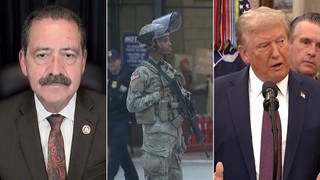
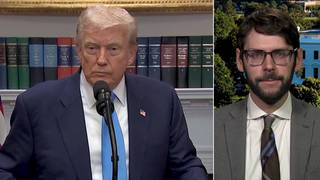
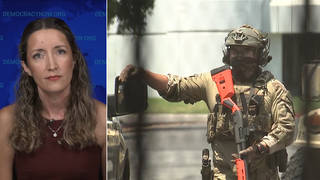
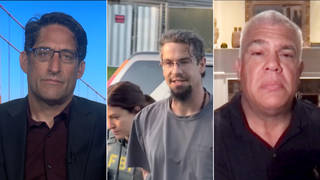
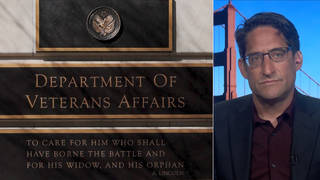
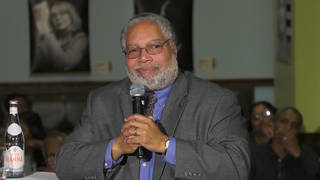

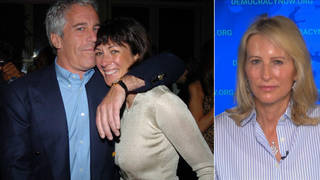

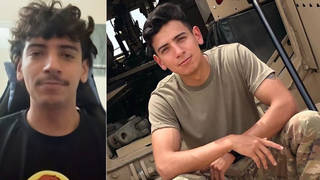
Media Options